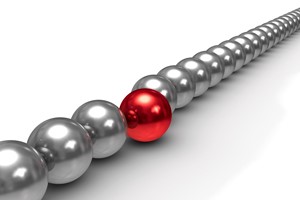Taking self-assembly to the limits

Researchers identify new ways of patterning gold nanoparticles with sub-10-nanometer resolution based on ‘structure transitions’ that occur when ordered states break down. © Sergey Ilin/istock/Thinkstock
Gold nanoparticles smaller than 10 nanometers spontaneously self-organize in entirely new ways when trapped inside channel-like templates. A new study shows that this feature could facilitate easier nanoscale manufacturing of biosensors and plasmonic devices with intricate, high-density surface structures[1].
Generating surface patterns at scales of 10 nanometers and below is difficult with current technology. An international team, led by Joel Yang from the A*STAR Institute of Materials Research and Engineering in Singapore, is helping to circumvent this limitation using a technique known as ‘directed self-assembly of nanoparticles’ (DSA-n).
This approach takes spherical nanoparticles that spontaneously organize into ordered, two-dimensional films when inserted into lithographically defined templates. The templates impose geometric constraints that force the films to organize into specific nanoscale patterns.
Most patterns produced by DSA-n, however, are simple periodic arrangements. To broaden this technique’s capabilities, researchers are exploring ‘structure transitions’ that occur when template constraints become comparable to the size of the nanoparticles. At these dimensions, the small spheres can dislocate from typical periodic positions and reorient into unpredictable new geometries.
Previous studies have used real-time video microscopy to capture structure transitions in microscale colloids, but direct imaging of sub-10-nanometer particles is nearly impossible. “That’s where we came up with the idea of using templates based on channels with gradually varying widths,” says co-author Mohamed Asbahi. “With this system, we can track the self-assembly of the nanoparticles according to the space accessible to them.”
Using electron-beam lithography techniques, the team carved out an array of inward tapering trenches designed to fit 1 to 3 rows of gold nanoparticles. After depositing a monolayer of 8-nanometer particles in the template, they used scanning electron microscopy to identify any emergent width-dependent patterns. Between periodically ordered rows, the researchers saw clear evidence of transition state zones — regions where the tiny spheres buckle out of alignment and gradually take on new, triangular packing patterns.
After analyzing the transition states with computational Monte Carlo simulations, Yang and co-workers identified several dominant recurrent patterns with different geometries from typical DSA-n depositions. Because the conditions needed to generate these patterns can be predicted mathematically, the team is confident these findings can have practical surface engineering applications.
“The success of DSA-n depends on the positioning accuracy of the particles,” says Yang. “By exploiting the rich set of structural geometries that exist between ordered states, we can design templates that guide particles into complex periodic and nonperiodic structures.”
The A*STAR-affiliated researchers contributing to this research are from the Institute of Materials Research and Engineering
Reference:
[1] Asbahi, M., Mehraeen, S., Lim, K. T. P, Wang, F., Cao, J., Tan, M. C. & Yang, J. K. W. Template-induced structure transition in sub-10 nm self-assembling nanoparticles. Nano Letters 14, 2642–2646 (2014).
Media Contact
All latest news from the category: Materials Sciences
Materials management deals with the research, development, manufacturing and processing of raw and industrial materials. Key aspects here are biological and medical issues, which play an increasingly important role in this field.
innovations-report offers in-depth articles related to the development and application of materials and the structure and properties of new materials.
Newest articles

NASA: Mystery of life’s handedness deepens
The mystery of why life uses molecules with specific orientations has deepened with a NASA-funded discovery that RNA — a key molecule thought to have potentially held the instructions for…

What are the effects of historic lithium mining on water quality?
Study reveals low levels of common contaminants but high levels of other elements in waters associated with an abandoned lithium mine. Lithium ore and mining waste from a historic lithium…

Quantum-inspired design boosts efficiency of heat-to-electricity conversion
Rice engineers take unconventional route to improving thermophotovoltaic systems. Researchers at Rice University have found a new way to improve a key element of thermophotovoltaic (TPV) systems, which convert heat…



